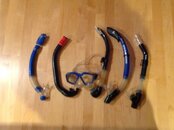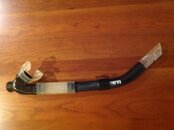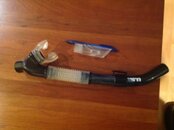You are using an out of date browser. It may not display this or other websites correctly.
You should upgrade or use an alternative browser.
You should upgrade or use an alternative browser.
snorkel differences..real or imagined?
- Thread starter bluedogs
- Start date
Please register or login
Welcome to ScubaBoard, the world's largest scuba diving community. Registration is not required to read the forums, but we encourage you to join. Joining has its benefits and enables you to participate in the discussions.
Benefits of registering include
- Ability to post and comment on topics and discussions.
- A Free photo gallery to share your dive photos with the world.
- You can make this box go away
David Wilson
Contributor
After 50 years, I have never found a snorkel better than a mid 70's Farallon contour snorkel with the swivel mouthpiece. Simple, works left or right, clears easy....
Farallon may be best remembered for its then innovative Fara-Fins, which came with leg braces:
However, the firm also manufactured snorkels with patented mouldable mouthpieces. Here's the snorkel models page from a late 1970s/early 1980s diving equipment catalogue of Farallon Industries, whose products were distributed in the UK by Collins and Chambers Ltd of London:
Was your snorkel one of the breathing tubes illustrated above? If you're interested in the scanned Farallon catalogue, visit https://tinyurl.com/ycbdka5c.
Last edited:
Kharon
Contributor
No, the simple snorkels just work much better, have less drag, and clear with marvelous ease. Their use can be mastered very quickly.
Dogmatic - dive and let dive. ==> Ignore
You seem to take divergent opinions rather personally. Do you think professional counseling might help?Dogmatic - dive and let dive. ==> Ignore
scrane
Contributor
The first snorkel I used was of the ping-pong ball in a cage variety. I soon learned it had technical limitations.
When I got to the point where I'd free dive to spear lunch I learned to use the standard, unadorned wide tube.
The most important design aspect for me is that the snorkel reaches from the air supply to my mouth comfortably.
When I got to the point where I'd free dive to spear lunch I learned to use the standard, unadorned wide tube.
The most important design aspect for me is that the snorkel reaches from the air supply to my mouth comfortably.
CT Sean
Contributor
If you want a dry snorkel a Tusa Hyperdry works well.
Another vote for Tusa Hyperdry. I've been using an Imprex Hyperdry ( the current version is Imprex II TUSA Imprex II Hyperdry Flex Snorkel ) for a good 15 years or so and it hasn't failed me yet. Purge never leaks, and the simple baffle at the top does a very good job of keeping water out. I like it enough that I got them for both kids and my wife when they needed snorkels
My first snorkel was a normal simple one, without any valves nor anything extra. It worked, but it was frustrating those times I had emptied my lungs and then got surprise water (because one sinks slightly when exhaling) and there was not enough of air in my lungs to blow it out. One friend had a semi-dry snorkel and I tried it and I got surprised of how little air was needed to empty it. After this I bought a Scubapro Spectre and I have been very happy with it. I almost never get any surprise water into this snorkel and if I would get I am usually able to expel it with whatever air I happen to have left in my lungs at that moment.
There is a real diffe ence between snorkels. I have been snorkeling since 1958, in rivers, lakes, and as an USAF Pararescueman beneath helicopters. I started with a hard plastic "C"-shaped snorkel with a ping pong ball stopper, and when that frustrated me, I cut off the top of the "C" to make a "J" snorkel, which I used for years until I bought a rubber one with a corrugated hose/mouthpiece. But this one folded shut in a river current over my jaw, so I got a flexible AMF Voit one with a hard mouthpiece which wouldn't fold in a current. This one lasted until I got into the USAF, and was issurpd a curved J-shaped snorkel. None of these were the modern "dry" style snorkels.
We learned to use these snorkels in chop, sensing when water was entering and blowing them clear. We also learned to clear the snorkel using the displacement method, rather than the blow method, as it was easier. Simply by looking up and lightly exhaling about three feet, or one meter, underwater when surfacing, we displaced the water in the snorkel and continued the exhalation to the surface, where the snorkel would be clear.
In the 1980s I found out about a new, dry snorkel by Scubapro, the Shotgun snorkel. I used this snorkel on a 18 mile river "Vets Swim for the Needy" event, and I was the only finisher of this swim. I had cut down the snorkel top to give me less dead air space, and the snorkel worked wonderfully. I have been using this snorkel for my primary ever since, and have three of them (including the Shotgun II snorkel I recently picked up. This snorkel does not interfere with air passage or create further breathing resistance other than the length of the snorkel as there is nothing in the air passage to cause resistance to breathing.
In the 1990s I evaluated a number on snorkels to figure out the best for my family, and determined that the U.S. Divers Company Impulse snorkel was best. It was dry, using a dome on top with a top valve to allow water coming down the tube to exit at the dome, and a catch area under the mouthpiece with a mushroom exhaust valve at the low point. This again made for a very dry snorkel without breathing resistance, but divers did not like the dome at the top, so it was discontinued.
A number of other "dry" snorkels have been developed, but all use variations which depend upon creating breathing resistance to blow water out of the bottom exhaust valve. One Aqualung snorkel uses a floating valve at the top to close off the tube, but sometimes it doesn't open when needed and increases the resistance to breathing too. TUSA has a snorkel with a curved top and a plastic cover to ensure water doesn't directly go down the tube, but the curve does increase breathing resistance. All of these dry snorkels depend upon this increase of breathing resistance to expel water out of the mouthpiece.
A newer style by U.S. Divers depends upon two overlapping platforms with slits in the snorkel; it is a separate plastic attachment placed into the top of this snorkel tube. I have found this to be a nearly ideal snorkel if I take that attachment off the top and use the shorter snorkel as a wet snorkel. If I get too much water into the mouthpiece, I simply plug the top with my hand and blow the water out the mushroom valve under the mouthpiece.
SeaRat
PS, David Richie Wilson has elsewhere published EU requirements concerning minimum tube diameters for male and female adults, and I think for children too. I have much more to say and show about snorkels, but this is a good start.
We learned to use these snorkels in chop, sensing when water was entering and blowing them clear. We also learned to clear the snorkel using the displacement method, rather than the blow method, as it was easier. Simply by looking up and lightly exhaling about three feet, or one meter, underwater when surfacing, we displaced the water in the snorkel and continued the exhalation to the surface, where the snorkel would be clear.
In the 1980s I found out about a new, dry snorkel by Scubapro, the Shotgun snorkel. I used this snorkel on a 18 mile river "Vets Swim for the Needy" event, and I was the only finisher of this swim. I had cut down the snorkel top to give me less dead air space, and the snorkel worked wonderfully. I have been using this snorkel for my primary ever since, and have three of them (including the Shotgun II snorkel I recently picked up. This snorkel does not interfere with air passage or create further breathing resistance other than the length of the snorkel as there is nothing in the air passage to cause resistance to breathing.
In the 1990s I evaluated a number on snorkels to figure out the best for my family, and determined that the U.S. Divers Company Impulse snorkel was best. It was dry, using a dome on top with a top valve to allow water coming down the tube to exit at the dome, and a catch area under the mouthpiece with a mushroom exhaust valve at the low point. This again made for a very dry snorkel without breathing resistance, but divers did not like the dome at the top, so it was discontinued.
A number of other "dry" snorkels have been developed, but all use variations which depend upon creating breathing resistance to blow water out of the bottom exhaust valve. One Aqualung snorkel uses a floating valve at the top to close off the tube, but sometimes it doesn't open when needed and increases the resistance to breathing too. TUSA has a snorkel with a curved top and a plastic cover to ensure water doesn't directly go down the tube, but the curve does increase breathing resistance. All of these dry snorkels depend upon this increase of breathing resistance to expel water out of the mouthpiece.
A newer style by U.S. Divers depends upon two overlapping platforms with slits in the snorkel; it is a separate plastic attachment placed into the top of this snorkel tube. I have found this to be a nearly ideal snorkel if I take that attachment off the top and use the shorter snorkel as a wet snorkel. If I get too much water into the mouthpiece, I simply plug the top with my hand and blow the water out the mushroom valve under the mouthpiece.
SeaRat
PS, David Richie Wilson has elsewhere published EU requirements concerning minimum tube diameters for male and female adults, and I think for children too. I have much more to say and show about snorkels, but this is a good start.
Attachments
I am with him, the valve in the bottom means a lot of the force that is supposed to be blowing water out of the tube is lost, so you end up with more water left in the snorkel. It isn’t going to drain out the bottom because the pressure on the outside of the oneway valve isn’t lower than the pressure on the inside if I am not blasting it. So the only way to clear it Ian to tip your head back. How are you supposed to soak people standing on the poolside like that?Dogmatic - dive and let dive. ==> Ignore
Kharon
Contributor
My dry snorkel decided to start sticking and I was getting mouthfulls of water when I didn't expect it. I got a Tusa Hyperdry based on SB posts. It's still only semi-dry. I do get some water in it at times. So far no big deal and it clears very well.
One thing I found is that it breathes easy. On surface swims, especially after breathing from my reg, I found it marginal to get enough air on the dry snorkel. I always felt like it was hard to get air through it. The Tusa doesn't feel like that. I can tell it's slightly not quite as easy to breathe as the reg, but I get plenty of air.
I don't know if it's because of the dry flap or the bore in the dry snorkel, but I'll take the chance of a small amount of water over breathing hard every time. It's easy to curl my tongue to the back to keep from inhaling water when some gets in till I purge the water.
One thing I found is that it breathes easy. On surface swims, especially after breathing from my reg, I found it marginal to get enough air on the dry snorkel. I always felt like it was hard to get air through it. The Tusa doesn't feel like that. I can tell it's slightly not quite as easy to breathe as the reg, but I get plenty of air.
I don't know if it's because of the dry flap or the bore in the dry snorkel, but I'll take the chance of a small amount of water over breathing hard every time. It's easy to curl my tongue to the back to keep from inhaling water when some gets in till I purge the water.
Similar threads
- Replies
- 32
- Views
- 9,304
- Replies
- 8
- Views
- 695
- Replies
- 13
- Views
- 1,239
- Replies
- 20
- Views
- 2,131






